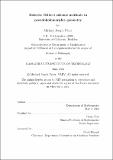Relative Hilbert scheme methods in pseudoholomorphic geometry
Author(s)
Usher, Michael Joseph, 1978-
DownloadFull printable version (511.6Kb)
Other Contributors
Massachusetts Institute of Technology. Dept. of Mathematics.
Advisor
Gang Tian.
Terms of use
Metadata
Show full item recordAbstract
This thesis takes up a program initiated by S. Donaldson and I. Smith aimed at using symplectic Lefschetz fibration techniques to obtain information about pseudoholomorphic curves in symplectic 4-manifolds. Donaldson and Smith introduced an invariant DS which counts holomorphic sections of a relative Hilbert scheme constructed from a symplectic Lefschetz fibration, and a number of considerations, including a duality relation for DS proven by Smith, led to the conjecture that DS agrees with the Gromov invariant G[gamma] earlier defined by C. Taubes in his study of Seiberg-Witten theory on symplectic manifolds. Our central result is a proof of this conjecture, which thus makes available new proofs of some results concerning pseudoholomorphic curves which had previously only been accessible via gauge theory. The crucial technical ingredient in the proof is an argument which allows us to work with curves C in the total space of the Lefschetz fibration that are made holomorphic by an almost complex structure which is integrable near C and with respect to which the fibration is a pseudoholomorphic map. We also introduce certain refinements of DS and show that these refinements are equal to Gromov invariants which count pseudoholomorphic subvarieties of symplectic 4-manifolds with a prescribed decomposition into reducible components. We prove a vanishing result for some of these invariants which might bear on the question of the uniqueness of the decomposition of the canonical class of a symplectic 4-manifold into classes with nontrivial Gromov-Witten invariants.
Description
Thesis (Ph. D.)--Massachusetts Institute of Technology, Dept. of Mathematics, 2004. Includes bibliographical references (p. 103-104). This electronic version was submitted by the student author. The certified thesis is available in the Institute Archives and Special Collections.
Date issued
2004Department
Massachusetts Institute of Technology. Department of MathematicsPublisher
Massachusetts Institute of Technology
Keywords
Mathematics.